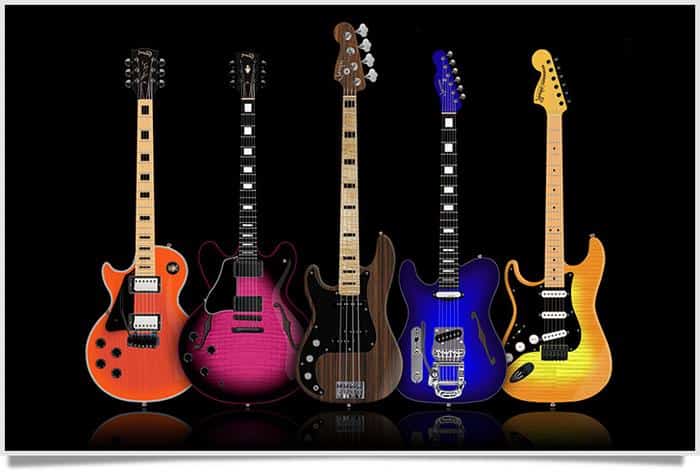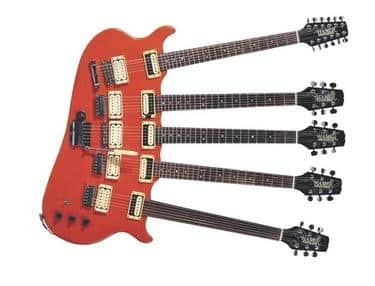Imagine a guitar that not only defies conventional design, but transcends the realm of musical instruments, becoming a symbol of inventiveness and audacity. This is the indomitably singular five-neck guitar. This gargantuan innovation, synonymous with rock legend Rick Nielsen, nudged guitar history onto a path less travelled. As an experienced luthier and ardent fan of guitar innovation, I can’t wait to share the remarkable journey of the five-neck guitar.
Picture your traditional guitar, and now imagine multiplying it by five. Sounds exhilarating or perhaps, perplexing? That’s precisely the enigma of the five-neck guitar. Its flamboyant design and reason for existence have always intrigued me and many others. So unique, it questions the very ergonomics of conventional guitar creation. Intricate details, hidden clues, and a bold evolution – join me as we strum through the compelling story of its origins, the impact of Rick Nielsen, and the unforgettable five-neck guitar’s crucial role in broadening our perception of what a guitar can be.
Immerse in the journey of this behemoth instrument, as we reveal how it has slowly carved a niche in guitar history. With its every chord, the five-neck guitar song forges on, echoing through collections, exhibits and even the market, whispering tales of rock’n’roll audacity and innovation.
Origins of Multi-neck Guitars
First Design Steps

Drawing from my experiences in engineering and instrument design, I hold a vantage point to appreciate the innovation and craftsmanship necessary in creating multi-neck, possibly exotic guitars. The initial steps in the evolution of these impressive instruments began with a seed thought: to enhance guitar design possibilities. Craftsmen strived to merge distinct tonalities within a single instrument to provide musicians a wider palette.
The notion wasn’t just to make a commercial splash. Rather, the pursuit was a calculated attempt to provide artists with an advanced variant capable of breaking the tradition of switching guitars for different sounds during performances. This phase in the ‘Origins of Multi-neck Guitars’ journey is crucial for understanding the reasons behind these radical designs.
Looking at the history of five-neck guitar, the first design steps were an inspired answer to the simple, profound question: “What if we could play different tones on the same guitar?” The answer led to a significant shift in guitar design, eventually culminating with Rick Nielsen’s legendary five-neck guitar.
Keep in mind, this inventive ambition wasn’t only concerned with aesthetics; it aimed to stretch what was playable, pushing the boundaries of musicality and design into new, often exotic terrain. This thrilling narrative continues as we delve into the evolution of the quint neck, a gargantuan leap forward in multi-neck guitar craftsmanship.
The Evolution to Quint Neck

When discussing the journey of multi-neck guitars, it’s essential to address the point at which novelty guitars took a turn towards the avant-garde; the inception of the quint neck guitar. Building on my own experiences with crafting stringed instruments, I have a unique perspective on the fascinating evolution of these guitars.
The quint neck guitar serves as a testament to the audacity and inventiveness of guitar design. It’s not merely a representation of increased complexity; instead, quint neck guitars delineated a new approach to conceptualizing musical possibilities. This leap in design didn’t occur through a singular, definitive moment, but evolved gradually with musicians and luthiers tirelessly experimenting with the boundaries of their craft.
Each neck, with its distinct tuning and more stringent playing requirements, not only added physical weight but also increased the sonic possibilities for the player. The progression to quint necks offered musicians an expansive palette of tones and frequencies, effectively acting as multiple guitars in one.
As a builder, the quint neck presents a fascinating blend of musical requirements and aesthetic considerations. Its emergence embodies a critical juncture within the development of multi-neck guitars. As we turn the page into examining Rick Nielsen’s legendary five-neck guitar, it’s worth appreciating how this daring design shifted the conversation within the music world.
Rick Nielsen and His Legendary Five-Neck Guitar
The Creation of an Icon

In many ways, Rick Nielsen’s five-neck guitar represents the epitome of custom guitars. I stumbled upon this legendary guitar as part of my deeper exploration into the world of custom instruments. The unique design caught my eye, but it was the story and significance behind its creation that intrigued me more.
It’s important to understand that the five-neck guitar wasn’t spawned from a random idea. Nielsen, an insatiable lover of legendary guitars, always had an affinity for unusual, custom-made pieces with a definitive character. Tapping into his adventurous spirit, he collaborated with Hamer Guitars, a renowned name in the custom guitars industry. What emerged was an embodiment of Nielsen’s creativity and non-standard approach to his craft: a five-neck guitar.
By pushing the boundaries of conventionality, Nielsen’s guitar became an unprecedented contribution to the realm of custom guitars. It raised questions, fuelled discussion, and unfathomably broadened the horizons of guitar design. This icon was no longer just an instrument, but a symbol of audacity in the guitar world, embodying the notion that there’s no limit to artistic invention.
Yet, the five-neck guitar was not just a show piece—it was frequently used by Nielsen during concerts, further imprinting its significance to Nielsen’s stage persona and musicality. Thus, the guitar became indispensable in Nielsen’s repertoire, securing its place in the annals of custom guitar history. By challenging the status quo, it helped reshape perceptions on the potential of personalized, ornamented instruments, ultimately paving the way for a bolder approach to guitar design.
When discussing the evolution and significance of custom guitars, Rick Nielsen’s five-neck guitar holds a revered position. As we move towards understanding its use and impact, it’s key to remember the duality of it being both a groundbreaking innovation and a symbolic testament of the limitless potential of customization in guitar design.
Use and Impact

Understanding Rick Nielsen’s use of the five-neck guitar as well as its impact on the music industry and guitar design is crucial. Nielsen was never one for traditional manual manipulation of his guitar. His approach involved a complex series of shifts between the guitar hero necks, resulting in an unparalleled compatibility between artist and instrument. This undeniably contributes to his status as a legend in the rock and roll hall of fame, with his band Cheap Trick reaching iconic status as pioneers of the genre.
Every time Nielsen took to the stage with his five-neck guitar, it was more than just an exciting visual spectacle – it was a masterclass in innovative musicianship. The quint-neck guitar became an extension of his electrifying persona, His performances have always exhilarated me and as an aficionado of ergonomics in guitar design, I can’t help but marvel at how seamlessly he weaves through the musical narrative crafted by each individual neck.
The impact this had on audiences and fellow musicians alike was substantial. It was more than just a gimmick or a show-stopping spectacle. This was an instrument that pushed the boundaries of guitar design, and changed facets of popular music culture. It became a symbol of ingenuity, guts, and the power of unconventionality. Nielsen, with his revolutionary guitar, has left an indelible mark on the world of music. His distinctive use of the five-neck guitar and its tremendous cultural impact are testament to his creative genius – enlightening us to ever-innovative potentialities in the art of guitar playing, tuning and design.
No matter how much music evolves, the image of Nielsen wielding his legendary five-neck guitar will remain a seductive spectacle. His unique use of this incredible instrument has irrefutably reinforced his place in music’s hall of fame, and written forever into the annals of guitar history the indomitable impact of the five neck guitar.
Five-Neck Guitars in Collections and Exhibits
Exhibits and Displays

As a long-standing member of the New England Luthiers group, I am deeply committed to the recognition and conservation of unique guitars. To me, there is no exhibit more exciting than those featuring five-neck guitars. Their extraordinary structure and commanding presence never fail to captivate.
A noteworthy celebration of the five-neck guitar resided within the illustrious Metropolitan Museum of Art guitar exhibit. This remarkable display served to underscore the instrument’s historical significance and unique design elements. Witnessing these guitars in such revered spaces amplifies their cultural contribution and allows us to experience firsthand the physicality behind the incredible sound.
These exhibits and displays showcase the fusion of innovative design and superb craftsmanship that embody the five-neck guitar. The guitars are not simply silent objects within a case. They speak clearly of the tireless experimentation and iconic virtuosity of musicians like Rick Nielsen who dared to push traditional limitations.
Inevitably, such glorification of the five-neck guitar in high-profile exhibits adds to its intrigue and desirability within the market. The more we value these guitars in such cultural and aesthetic spaces, the more we recognize their irreplaceable role within music history.
The Market for Five-Neck Guitars

As we move from five-neck guitars exhibited in collections or on stages to their presence in the market, my role as a lutherie community’s connector conspicuously comes into play. It allows me a captivating gaze into the world of guitar collectors, as these unique instruments certainly pique their interest.
Finding its niche in the market, the five-neck guitar may not always be the most practical choice for musicians but is considered a collector’s delight. It becomes a symbol of opulence and finesse in their collections. These enthusiasts actively seek models from brands such as Spector Bass guitars, known for their exceptional craftsmanship and sound quality.
With their hybrid nature and historical imprints, five-neck guitars have infused a new vitality into the broader guitar market. Through their larger-than-life presence, they add a touch of rarity and luxury to any collection they grace. Having witnessed this distinctive market segment, I must say these masterpieces continue to inspire awe, appreciating value in the eyes of collectors and musicians alike.
Craving more eccentric guitar knowledge? Stay tuned for our Frequently Asked Questions section right after this.
FAQs
Who is Rick Nielsen?
What is Rick Nielsen’s five-neck guitar?
How did Rick Nielsen’s five-neck guitar contribute to his Rock-n-Roll persona?
What impact did Nielsen’s five-neck guitar have on the music industry?
Conclusion
Was the five-neck guitar’s creation a historic moment or was it a spectacular novelty? Time to draw our conclusions.
The five-neck guitar, a seemingly extravagant stage prop, is undeniably an irreplaceable part of the evolution of electric guitars. Its inception, driven by Rick Nielsen’s daring vision, proved it was more than just a spectacle, influencing a wave of invention and experimentation within the genre.
In my journey through lutherie, I’ve uncovered how such unique entities, though unconventional, are instrumental in pushing the boundaries of what’s possible in music. The five-neck guitar, a perfect illustration of this, has been a source of inspiration and excitement for myself and countless others.
From its initial design steps to becoming a quintessential emblem of rock ‘n’ roll extravagance, this instrument’s journey mirrors the relentless spirit of innovation in music. Its enduring popularity not only stands testament to its significant impact but also highlights its coveted position in collections, exhibits, and the wider market.
As we conclude, let us remember and salute Nielsen’s audacious spirit, for without it, we wouldn’t have this marvelous genre-bending phenomenon called the five-neck guitar. In its essence, it is an extraordinary link between technical skill, craftsmanship, and artistic vision.
I hope this guide has enlightened you about its marvel and encourages you to uphold the spirit of pushing boundaries, similar to how Nielsen did with this iconic creation.